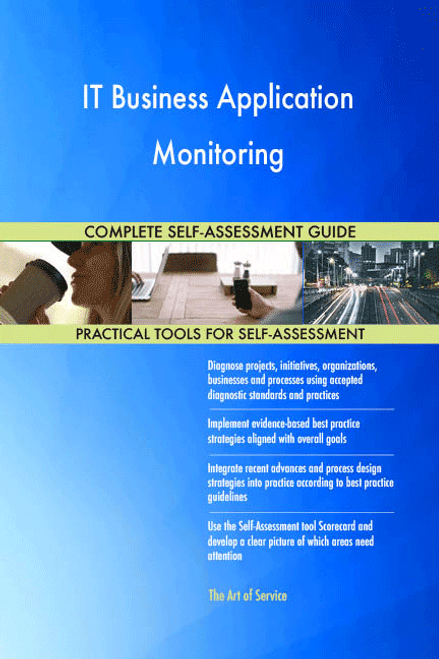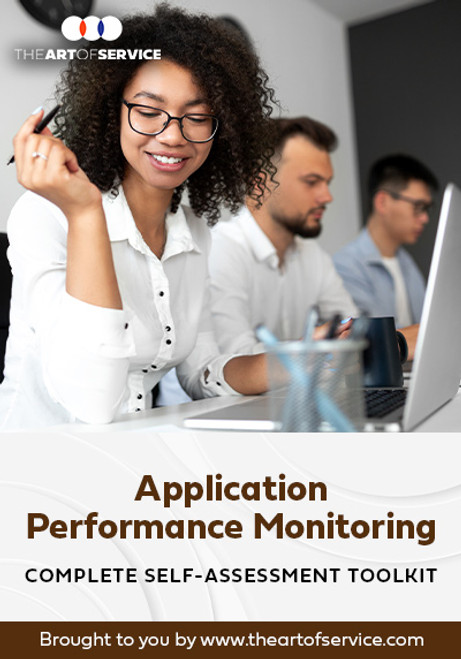Methodize Application Monitoring: partner in activities related to Systems Development, new geographies/verticals, and analyze new policies to ensure that control considerations are captured.
More Uses of the Application Monitoring Toolkit:
- Confirm your business complies; DevOps standardize Application Development tools, standard process/practice, Enterprise Architecture, continuous deployment, and Application Monitoring capabilities.
- Make sure that your project complies; DevOps standardize Application Development tools, standard process/practice, Enterprise Architecture, continuous deployment, and Application Monitoring capabilities.
- Make sure that your organization complies; DevOps standardize Application Development tools, standard process/practice, Enterprise Architecture, continuous deployment, and Application Monitoring capabilities.
- Resolve complex issues and problems arising due to performance of the applications, Identify the trends in Application Monitoring.
- Be certain that your design identifies and evaluates Industry Trends in application technologies, to serve as a source of information and advice for upper management.
- Steer Application Monitoring: investigation of user queries as order flow breaks, booking issues, application trading issues, regulatory issues, liaison with operations and controllers.
- Lead Requirements Gathering, Solution Design and schedule development for application Releases and patches in traditional Data Centers and Cloud environments.
- Steer Application Monitoring: partner with other technology leaders to establish architectural patterns, increase Application Supportability, improve Service Levels, and adhere to security standards.
- Ensure your organization follows proper Change Management practices as it relates to user administration and client/server side application updates.
- Evaluate Application Monitoring: design a fast, resilient, and scalable application which incorporates technical infrastructure strategy, configuration, and management and provide solutions to optimize performance and scalability.
- Provide insight into Best Practices with automation, Systems Management, processes and standards, application performance, capability, and tuning, and storage and Network Management.
- Confirm your organization partners with the Product Owner to understand Business Requirements, evaluates features, and translates application specifications into workable technical solutions.
- Work with customers teams of Business Analysts to providE Business Application Support for all of your organizations Financial Management systems and related applications.
- Manage work with other IT and application teams to Implement Automation of processes and improved monitoring of systems.
- Confirm your venture complies; partners heavily with application, data, and technology enterprise architects to develop and integrate information and Application Architectures, strategies, approaches, policies, standards, etc.
- Support PC hardware components, desktop Operating System software, and Application Software.
- Direct Application Monitoring: Test Engineering for implementing application testing and testing Infrastructure as Code.
- Manage Application Monitoring: ownership of thE Business Application Services offering, provide solutions that Support Automation, digitization and Software Development life cycle.
- Develop a brand new web based application from the ground up and develop it with reliability and observability in mind.
- Identify Application Monitoring: work together with System Administrators, network planners and application developers to deliver innovative technology solutions using Azure Public Cloud services.
- Be accountable for providing design guidance that follows the Enterprise Architecture vision and adheres to applicable application technology guidelines; and mitigating the impact of Technical Design to security, performance and Data Privacy.
- Warrant that your business serves as application owner for systems that support IT Portfolio management and IT Resource Management.
- Organize Application Monitoring: Application Security engineers to manage your security team.
- Develop Planning Sessions with all Capacity planners to right size the Virtual Machines based on thE Business partners and application requirements.
- Govern Application Monitoring: tangible application of engineering and Continuous Improvement.
- Develop practical application training missions, mission scenarios, and mission evaluation tests /demonstrations, etc.
- Develop databases, User Interfaces, Application Logic, and reporting solutions for engineering users.
- Manage Application Monitoring: Application Services Relationship Management.
- Collaborate with technical Development Teams and coordinate work efforts when addressing implementations, functionality enhancements, application updates and performance issues.
- Collaborate with different teams on all aspects of Software Development from Requirements Gathering to release into production.
- Lead evaluation and monitoring of the success of training programs;follow up to ensure Training Objectives are met.
- Supervise Community Management to drive positive brand conversations.
Save time, empower your teams and effectively upgrade your processes with access to this practical Application Monitoring Toolkit and guide. Address common challenges with best-practice templates, step-by-step Work Plans and maturity diagnostics for any Application Monitoring related project.
Download the Toolkit and in Three Steps you will be guided from idea to implementation results.
The Toolkit contains the following practical and powerful enablers with new and updated Application Monitoring specific requirements:
STEP 1: Get your bearings
Start with...
- The latest quick edition of the Application Monitoring Self Assessment book in PDF containing 49 requirements to perform a quickscan, get an overview and share with stakeholders.
Organized in a Data Driven improvement cycle RDMAICS (Recognize, Define, Measure, Analyze, Improve, Control and Sustain), check the…
- Example pre-filled Self-Assessment Excel Dashboard to get familiar with results generation
Then find your goals...
STEP 2: Set concrete goals, tasks, dates and numbers you can track
Featuring 999 new and updated case-based questions, organized into seven core areas of Process Design, this Self-Assessment will help you identify areas in which Application Monitoring improvements can be made.
Examples; 10 of the 999 standard requirements:
- What are the Application Monitoring key cost drivers?
- What are the implications of the one critical Application Monitoring decision 10 minutes, 10 months, and 10 years from now?
- What are thE Business goals Application Monitoring is aiming to achieve?
- How will you measure your QA plan's effectiveness?
- What Application Monitoring data should be managed?
- Do you monitor the effectiveness of your Application Monitoring activities?
- Where do you need to exercise leadership?
- Are you / should you be revolutionary or evolutionary?
- What is a feasible sequencing of reform initiatives over time?
- Who owns what data?
Complete the self assessment, on your own or with a team in a workshop setting. Use the workbook together with the self assessment requirements spreadsheet:
- The workbook is the latest in-depth complete edition of the Application Monitoring book in PDF containing 994 requirements, which criteria correspond to the criteria in...
Your Application Monitoring self-assessment dashboard which gives you your dynamically prioritized projects-ready tool and shows your organization exactly what to do next:
- The Self-Assessment Excel Dashboard; with the Application Monitoring Self-Assessment and Scorecard you will develop a clear picture of which Application Monitoring areas need attention, which requirements you should focus on and who will be responsible for them:
- Shows your organization instant insight in areas for improvement: Auto generates reports, radar chart for maturity assessment, insights per process and participant and bespoke, ready to use, RACI Matrix
- Gives you a professional Dashboard to guide and perform a thorough Application Monitoring Self-Assessment
- Is secure: Ensures offline Data Protection of your Self-Assessment results
- Dynamically prioritized projects-ready RACI Matrix shows your organization exactly what to do next:
STEP 3: Implement, Track, follow up and revise strategy
The outcomes of STEP 2, the self assessment, are the inputs for STEP 3; Start and manage Application Monitoring projects with the 62 implementation resources:
- 62 step-by-step Application Monitoring Project Management Form Templates covering over 1500 Application Monitoring project requirements and success criteria:
Examples; 10 of the check box criteria:
- Cost Management Plan: Eac -estimate at completion, what is the total job expected to cost?
- Activity Cost Estimates: In which phase of the Acquisition Process cycle does source qualifications reside?
- Project Scope Statement: Will all Application Monitoring project issues be unconditionally tracked through the Issue Resolution process?
- Closing Process Group: Did the Application Monitoring Project Team have enough people to execute the Application Monitoring Project Plan?
- Source Selection Criteria: What are the guidelines regarding award without considerations?
- Scope Management Plan: Are Corrective Actions taken when actual results are substantially different from detailed Application Monitoring Project Plan (variances)?
- Initiating Process Group: During which stage of Risk planning are risks prioritized based on probability and impact?
- Cost Management Plan: Is your organization certified as a supplier, wholesaler, regular dealer, or manufacturer of corresponding products/supplies?
- Procurement Audit: Was a formal review of tenders received undertaken?
- Activity Cost Estimates: What procedures are put in place regarding bidding and cost comparisons, if any?
Step-by-step and complete Application Monitoring Project Management Forms and Templates including check box criteria and templates.
1.0 Initiating Process Group:
- 1.1 Application Monitoring project Charter
- 1.2 Stakeholder Register
- 1.3 Stakeholder Analysis Matrix
2.0 Planning Process Group:
- 2.1 Application Monitoring Project Management Plan
- 2.2 Scope Management Plan
- 2.3 Requirements Management Plan
- 2.4 Requirements Documentation
- 2.5 Requirements Traceability Matrix
- 2.6 Application Monitoring project Scope Statement
- 2.7 Assumption and Constraint Log
- 2.8 Work Breakdown Structure
- 2.9 WBS Dictionary
- 2.10 Schedule Management Plan
- 2.11 Activity List
- 2.12 Activity Attributes
- 2.13 Milestone List
- 2.14 Network Diagram
- 2.15 Activity Resource Requirements
- 2.16 Resource Breakdown Structure
- 2.17 Activity Duration Estimates
- 2.18 Duration Estimating Worksheet
- 2.19 Application Monitoring project Schedule
- 2.20 Cost Management Plan
- 2.21 Activity Cost Estimates
- 2.22 Cost Estimating Worksheet
- 2.23 Cost Baseline
- 2.24 Quality Management Plan
- 2.25 Quality Metrics
- 2.26 Process Improvement Plan
- 2.27 Responsibility Assignment Matrix
- 2.28 Roles and Responsibilities
- 2.29 Human Resource Management Plan
- 2.30 Communications Management Plan
- 2.31 Risk Management Plan
- 2.32 Risk Register
- 2.33 Probability and Impact Assessment
- 2.34 Probability and Impact Matrix
- 2.35 Risk Data Sheet
- 2.36 Procurement Management Plan
- 2.37 Source Selection Criteria
- 2.38 Stakeholder Management Plan
- 2.39 Change Management Plan
3.0 Executing Process Group:
- 3.1 Team Member Status Report
- 3.2 Change Request
- 3.3 Change Log
- 3.4 Decision Log
- 3.5 Quality Audit
- 3.6 Team Directory
- 3.7 Team Operating Agreement
- 3.8 Team Performance Assessment
- 3.9 Team Member Performance Assessment
- 3.10 Issue Log
4.0 Monitoring and Controlling Process Group:
- 4.1 Application Monitoring project Performance Report
- 4.2 Variance Analysis
- 4.3 Earned Value Status
- 4.4 Risk Audit
- 4.5 Contractor Status Report
- 4.6 Formal Acceptance
5.0 Closing Process Group:
- 5.1 Procurement Audit
- 5.2 Contract Close-Out
- 5.3 Application Monitoring project or Phase Close-Out
- 5.4 Lessons Learned
Results
With this Three Step process you will have all the tools you need for any Application Monitoring project with this in-depth Application Monitoring Toolkit.
In using the Toolkit you will be better able to:
- Diagnose Application Monitoring projects, initiatives, organizations, businesses and processes using accepted diagnostic standards and practices
- Implement evidence-based Best Practice strategies aligned with overall goals
- Integrate recent advances in Application Monitoring and put Process Design strategies into practice according to Best Practice guidelines
Defining, designing, creating, and implementing a process to solve a business challenge or meet a business objective is the most valuable role; In EVERY company, organization and department.
Unless you are talking a one-time, single-use project within a business, there should be a process. Whether that process is managed and implemented by humans, AI, or a combination of the two, it needs to be designed by someone with a complex enough perspective to ask the right questions. Someone capable of asking the right questions and step back and say, 'What are we really trying to accomplish here? And is there a different way to look at it?'
This Toolkit empowers people to do just that - whether their title is entrepreneur, manager, consultant, (Vice-)President, CxO etc... - they are the people who rule the future. They are the person who asks the right questions to make Application Monitoring investments work better.
This Application Monitoring All-Inclusive Toolkit enables You to be that person.
Includes lifetime updates
Every self assessment comes with Lifetime Updates and Lifetime Free Updated Books. Lifetime Updates is an industry-first feature which allows you to receive verified self assessment updates, ensuring you always have the most accurate information at your fingertips.







